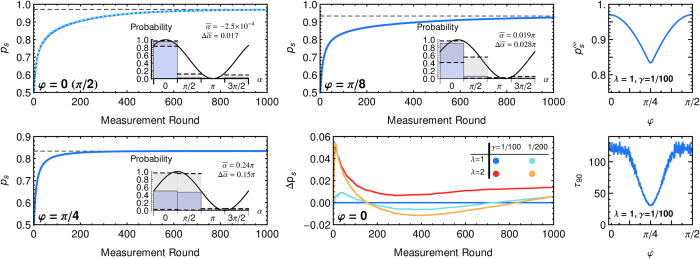Figure 3. Learning curves.

Left: The success probability ps as a function of number of measurement rounds on the qubit in state |φ〉 is shown for four angles as averaged over an ensemble of N = 1000 agents running in parallel (λ = 1, γ = 1/100). The time scale of learning can be rescaled by increasing both λ and γ. Dashed lines give analytical approximations of the asymptotic values (see text). The insets show the transition probabilities of the average agent after 1000 learning steps,  , where
, where  is the ensemble average of the weight hα, together with the minimal and maximal probabilities obtained in the ensemble (as error bars), and the analytical curve of p(+1|φ, α). From the transition/measurement probabilities of a single agent j we infer30,31 its mean angle
is the ensemble average of the weight hα, together with the minimal and maximal probabilities obtained in the ensemble (as error bars), and the analytical curve of p(+1|φ, α). From the transition/measurement probabilities of a single agent j we infer30,31 its mean angle  . The ‘‘vector sum’’ of the mean angles of the
. The ‘‘vector sum’’ of the mean angles of the  individual agents is the complex number
individual agents is the complex number  , which determines the ensemble average of the mean angle
, which determines the ensemble average of the mean angle  and its circular standard deviation
and its circular standard deviation  . Bottom middle: A higher reward scaling λ and lower damping rate γ give a faster initial learning and a higher asymptote, with a slower final convergence for the latter. Curves show the differences of all ps with the reference case λ = 1, γ = 1/100. Top right: Asymptotic success probability
. Bottom middle: A higher reward scaling λ and lower damping rate γ give a faster initial learning and a higher asymptote, with a slower final convergence for the latter. Curves show the differences of all ps with the reference case λ = 1, γ = 1/100. Top right: Asymptotic success probability  (analytical approximation) as a function of φ for 4 projectors. The curve is π/2-periodic. Bottom right: Learning time τ90 for the ensemble of agents to reach 90% of
(analytical approximation) as a function of φ for 4 projectors. The curve is π/2-periodic. Bottom right: Learning time τ90 for the ensemble of agents to reach 90% of  . Data is the average of the learning times of 1000 agents.
. Data is the average of the learning times of 1000 agents.
